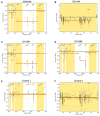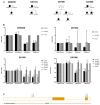Whole-Gene Deletions of FZD4 Cause Familial Exudative Vitreoretinopathy
- PMID: 34199009
- PMCID: PMC8306649
- DOI: 10.3390/genes12070980
Whole-Gene Deletions of FZD4 Cause Familial Exudative Vitreoretinopathy
Abstract
Familial exudative vitreoretinopathy (FEVR) is an inherited disorder characterized by abnormalities in the retinal vasculature. The FZD4 gene is associated with FEVR, but the prevalence and impact of FZD4 copy number variation (CNV) on FEVR patients are unknown. The aim of this study was to better understand the genetic features and clinical manifestations of patients with FZD4 CNVs. A total of 651 FEVR families were recruited. Families negative for mutations in FEVR-associated genes were selected for CNV analysis using SeqCNV. Semiquantitative multiplex polymerase chain reaction and multiplex ligation-dependent probe amplification were conducted to verify the CNVs. Four probands were found to carry whole-gene deletions of FZD4, accounting for 5% (4/80) of probands with FZD4 mutations and 0.6% (4/651) of all FEVR probands. The four probands exhibited similar phenotypes of unilateral retinal folds. FEVR in probands with CNVs was not more severe than in probands with FZD4 missense mutations (p = 1.000). Although this is the first report of FZD4 CNVs and the associated phenotypes, the interpretation of FZD4 CNVs should be emphasized when analyzing the next-generation sequencing data of FEVR patients because of their high prevalence.
Keywords: FZD4; copy number variation; familial exudative vitreoretinopathy; retinal fold; whole-gene deletion.
Conflict of interest statement
The authors declare no conflict of interest.
Figures







Similar articles
-
Genotype-phenotype associations in familial exudative vitreoretinopathy: A systematic review and meta-analysis on more than 3200 individuals.PLoS One. 2022 Jul 13;17(7):e0271326. doi: 10.1371/journal.pone.0271326. eCollection 2022. PLoS One. 2022. PMID: 35830446 Free PMC article.
-
FZD4 in a Large Chinese Population With Familial Exudative Vitreoretinopathy: Molecular Characteristics and Clinical Manifestations.Invest Ophthalmol Vis Sci. 2022 Apr 1;63(4):7. doi: 10.1167/iovs.63.4.7. Invest Ophthalmol Vis Sci. 2022. PMID: 35394490 Free PMC article.
-
Clinical and genetical features of probands and affected family members with familial exudative vitreoretinopathy in a large Chinese cohort.Br J Ophthalmol. 2021 Jan;105(1):83-86. doi: 10.1136/bjophthalmol-2019-315598. Epub 2020 Apr 1. Br J Ophthalmol. 2021. PMID: 32238352
-
Novel mutations in FZD4 and phenotype-genotype correlation in Chinese patients with familial exudative vitreoretinopathy.Mol Vis. 2016 Jul 30;22:917-32. eCollection 2016. Mol Vis. 2016. PMID: 27555740 Free PMC article.
-
Novel Exon 7 Deletions in TSPAN12 in a Three-Generation FEVR Family: A Case Report and Literature Review.Genes (Basel). 2023 Feb 25;14(3):587. doi: 10.3390/genes14030587. Genes (Basel). 2023. PMID: 36980859 Free PMC article. Review.
Cited by
-
De novel heterozygous copy number deletion on 7q31.31-7q31.32 involving TSPAN12 gene with familial exudative vitreoretinopathy in a Chinese family.Int J Ophthalmol. 2023 Dec 18;16(12):1952-1961. doi: 10.18240/ijo.2023.12.06. eCollection 2023. Int J Ophthalmol. 2023. PMID: 38111929 Free PMC article.
-
Genotype-phenotype associations in familial exudative vitreoretinopathy: A systematic review and meta-analysis on more than 3200 individuals.PLoS One. 2022 Jul 13;17(7):e0271326. doi: 10.1371/journal.pone.0271326. eCollection 2022. PLoS One. 2022. PMID: 35830446 Free PMC article.
-
Ocular manifestations of Chinese patients with copy number variants in the NDP gene.Mol Vis. 2022 Mar 25;28:29-38. eCollection 2022. Mol Vis. 2022. PMID: 35656167 Free PMC article.
-
Cellular and Molecular Mechanisms of Pathogenesis Underlying Inherited Retinal Dystrophies.Biomolecules. 2023 Feb 1;13(2):271. doi: 10.3390/biom13020271. Biomolecules. 2023. PMID: 36830640 Free PMC article. Review.
-
FZD4 in a Large Chinese Population With Familial Exudative Vitreoretinopathy: Molecular Characteristics and Clinical Manifestations.Invest Ophthalmol Vis Sci. 2022 Apr 1;63(4):7. doi: 10.1167/iovs.63.4.7. Invest Ophthalmol Vis Sci. 2022. PMID: 35394490 Free PMC article.
References
Publication types
MeSH terms
Substances
Supplementary concepts
LinkOut - more resources
Full Text Sources

